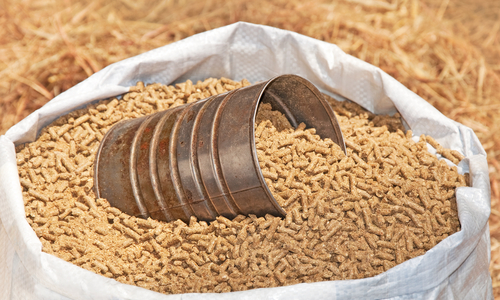
Having your feed tested is a way of ensuring your livestock are consuming the adequate nutrients they need in their diet. Poor nutrition can affect not only the productivity of the animal, but also its health and behavior. Forage and feed sampling is an essential tool in determining your animal feed quality. Waters Agricultural Laboratories offers a wide range of testing combinations that can help you determine the quality of your livestock feed.
Choose your lab for sample submittal forms:
Combination Analysis:
Feed Test 1: Moisture and Crude Protein
Feed Test 2: Moisture and Crude Protein plus Calcium and Phosphorus
Feed Test 3: Moisture, Crude Protein, Crude Fat, and Crude Fiber
Feed Test 4: Moisture, Crude Protein, Crude Fat, and Crude Fiber plus Calcium and Phosphorus
Feed Test 5: Moisture, Crude Protein, Crude Fiber, Total Digestible Nutrients and NET Energy
Feed Test 6: Moisture, Crude Protein, Crude Fiber, Total Digestible Nutrients and NET Energy plus Calcium and Phosphorus
Feed Test 7: Moisture, Crude Protein, Digestible Protein, Crude Fat, Crude Fiber, Nitrogen Free Extract, Total Digestible Nutrients, and Ash
Feed Test 8: Moisture, Crude Protein, Digestible Protein, Crude Fat, Crude Fiber, Nitrogen Free Extract, Total Digestible Nutrients, and Ash plus Calcium and Phosphorus
Pet Treat Analysis:
Waters Agricultural Laboratories, Inc. provides the analytical services necessary for manufacturers to be able to market their products efficiently. With a guaranteed analysis, the manufacturer and consumer alike will know exactly what their pets are being fed. A guaranteed analysis from Waters Agricultural Laboratories, Inc. will be your final step in getting your pet treats approved for marketing.
Feed Test 3: Moisture, Crude Protein, Crude Fat and Crude Fiber
Mineral Analysis:
Phosphorus, Potassium, Calcium, Magnesium, Zinc, Manganese, Iron, Copper, Sodium, Aluminum, and Molybdenum.
Understanding Your Feed Analysis Report
Dry Matter (DM) – Feed free of moisture of 100% DM. Feeds are expressed on a DM basis due to the large variation in moisture or DM content of feeds fed to cattle.
Crude Protein (CP) – Total protein equivalent including nitrogen from both protein and non-protein sources.
Unavailable Protein (Heat Damage) – Bound protein in the fiber of feed material. Normally about 1% protein (on a DM basis) is found. Values >1% indicate heat damage.
Adjusted Crude Protein – The amount of protein available to the animal. It is an adjustment to crude protein by unavailable protein.
Digestible Protein Estimate – An estimate of the amount of protein digested and absorbed by the animal.
Acid Detergent Fiber (ADF) – The percentage of highly indigestible plant material in a feed or forage. The lower the ADF the more digestible a feed is to the animal.
Neutral Detergent Fiber (NDF) – The percentage of cell wall material or plant structure in a feed. The lower the NDF percentage, the more an animal will eat. NDF includes acid detergent fiber and is inversely related to intake, therefore, a low percentage of NDF is desirable.
Total Digestible Nutrients (TDN) – The sum of the digestible protein, digestible nitrogen free extract, digestible crude fiber and the digestible fat. TDN accounts for the fecal loss of digestion and to a large extent the urinary energy loss.
Net Energy of Lactation (NEL) – An estimate of the energy in feed available for body maintenance and mike secretion.
Net Energy of Gain (NEG) – An estimate of the energy of feed available for the deposition of body tissue in non-lactating animals (the term “non-lactating animals” refers to growing males and females, and mature bulls).
Net Energy Maintenance (NEM) – An estimate of the energy of feed available for the maintenance of non-lactating animals.
Relative Feed Value (RFV) – A measure of feed value compared to full bloom pure alfalfa where 100 is equal to full bloom alfalfa. An RFV above 100 is better quality forage than an RFV below 100.
Macro Minerals – Minerals required in greater quantities and are present in animal tissue at higher levels. These include phosphorus, calcium, potassium, magnesium, sulfur sodium and chlorine.
Trace Minerals – Minerals required in smaller amounts and are generally present in animal tissue at lower levels. These include copper, iron, manganese and zinc.
Memberships & Affiliations:
- American Feed Control Officials (AAFCO)
- National Forage Testing Association (NFTA)
- American Oil Chemists’ Society (AOCS)
Please contact the lab for services that are not listed above.
